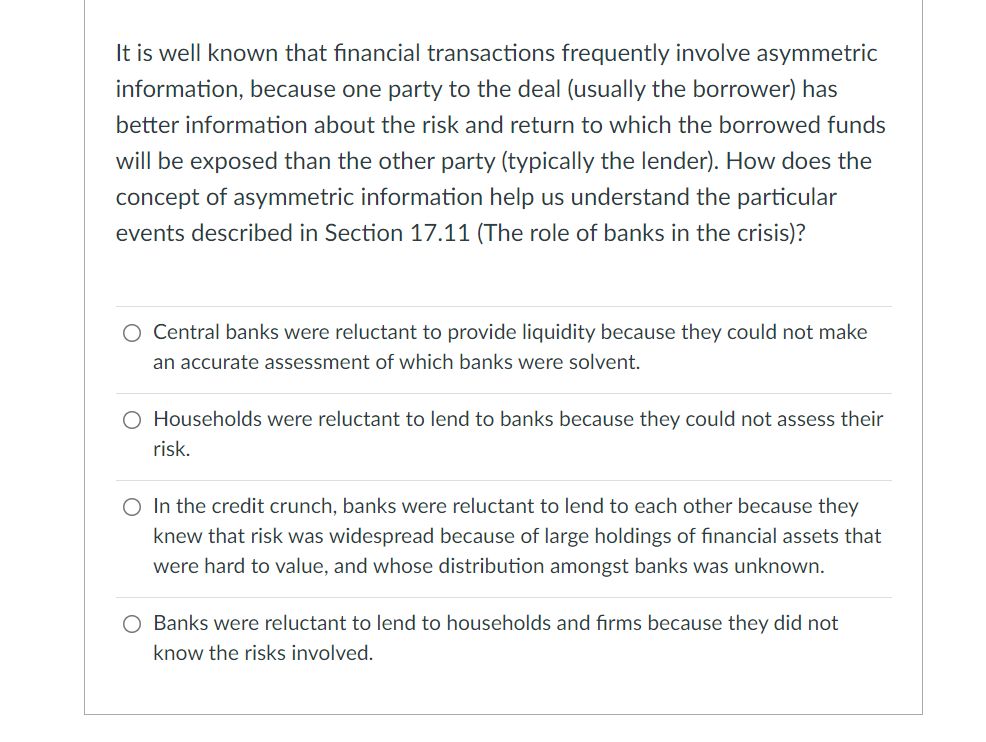It is well known that financial transactions frequently involve asymmetric information, because one party to the deal (usually the borrower) has better information about the risk and return to which the borrowed funds will be exposed than the other party (typically the lender). How does the concept of asymmetric information help us understand the particular events described in Section 17.11 (The role of banks in the crisis)? O Central banks were reluctant to provide liquidity because they could not make an accurate assessment of which banks were solvent. O Households were reluctant to lend to banks because they could not assess their risk. O In the credit crunch, banks were reluctant to lend to each other because they knew that risk was widespread because of large holdings of financial assets that were hard to value, and whose distribution amongst banks was unknown. O Banks were reluctant to lend to households and firms because they did not know the risks involved.
It is well known that financial transactions frequently involve asymmetric information, because one party to the deal (usually the borrower) has better information about the risk and return to which the borrowed funds will be exposed than the other party (typically the lender). How does the concept of asymmetric information help us understand the particular events described in Section 17.11 (The role of banks in the crisis)? O Central banks were reluctant to provide liquidity because they could not make an accurate assessment of which banks were solvent. O Households were reluctant to lend to banks because they could not assess their risk. O In the credit crunch, banks were reluctant to lend to each other because they knew that risk was widespread because of large holdings of financial assets that were hard to value, and whose distribution amongst banks was unknown. O Banks were reluctant to lend to households and firms because they did not know the risks involved.
Essentials of Economics (MindTap Course List)
8th Edition
ISBN:9781337091992
Author:N. Gregory Mankiw
Publisher:N. Gregory Mankiw
Chapter19: The Basic Tools Of Finance
Section: Chapter Questions
Problem 4CQQ
Related questions
Question
5.

Transcribed Image Text:It is well known that financial transactions frequently involve asymmetric
information, because one party to the deal (usually the borrower) has
better information about the risk and return to which the borrowed funds
will be exposed than the other party (typically the lender). How does the
concept of asymmetric information help us understand the particular
events described in Section 17.11 (The role of banks in the crisis)?
O Central banks were reluctant to provide liquidity because they could not make
an accurate assessment of which banks were solvent.
O Households were reluctant to lend to banks because they could not assess their
risk.
O In the credit crunch, banks were reluctant to lend to each other because they
knew that risk was widespread because of large holdings of financial assets that
were hard to value, and whose distribution amongst banks was unknown.
O Banks were reluctant to lend to households and firms because they did not
know the risks involved.
Expert Solution
This question has been solved!
Explore an expertly crafted, step-by-step solution for a thorough understanding of key concepts.
Step by step
Solved in 2 steps

Knowledge Booster
Learn more about
Need a deep-dive on the concept behind this application? Look no further. Learn more about this topic, economics and related others by exploring similar questions and additional content below.Recommended textbooks for you

Essentials of Economics (MindTap Course List)
Economics
ISBN:
9781337091992
Author:
N. Gregory Mankiw
Publisher:
Cengage Learning

Brief Principles of Macroeconomics (MindTap Cours…
Economics
ISBN:
9781337091985
Author:
N. Gregory Mankiw
Publisher:
Cengage Learning

Principles of Economics 2e
Economics
ISBN:
9781947172364
Author:
Steven A. Greenlaw; David Shapiro
Publisher:
OpenStax

Essentials of Economics (MindTap Course List)
Economics
ISBN:
9781337091992
Author:
N. Gregory Mankiw
Publisher:
Cengage Learning

Brief Principles of Macroeconomics (MindTap Cours…
Economics
ISBN:
9781337091985
Author:
N. Gregory Mankiw
Publisher:
Cengage Learning

Principles of Economics 2e
Economics
ISBN:
9781947172364
Author:
Steven A. Greenlaw; David Shapiro
Publisher:
OpenStax